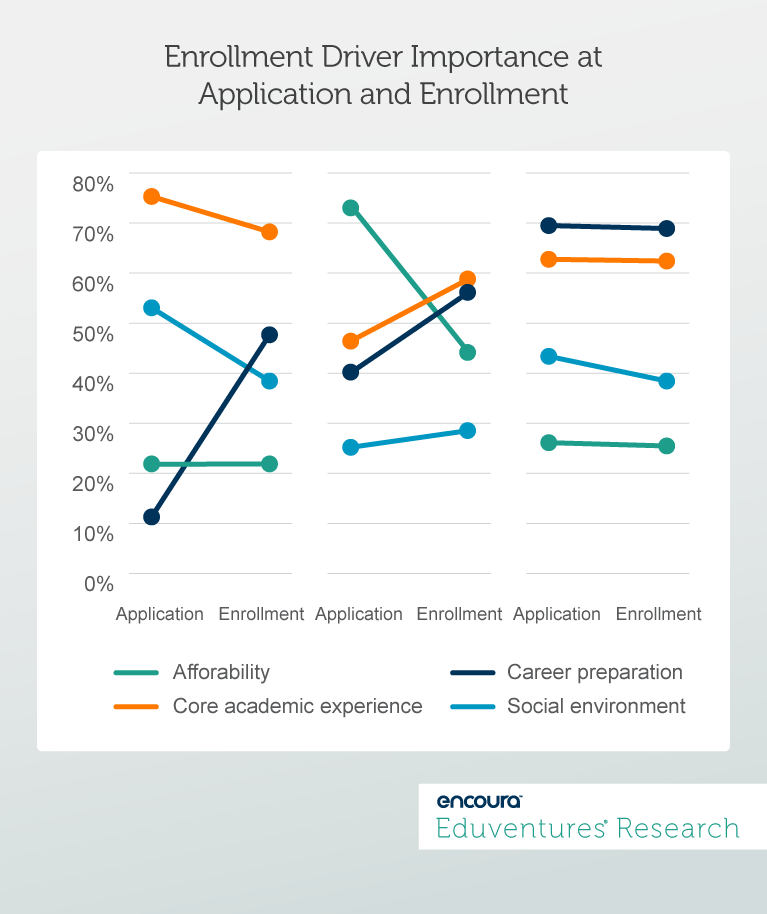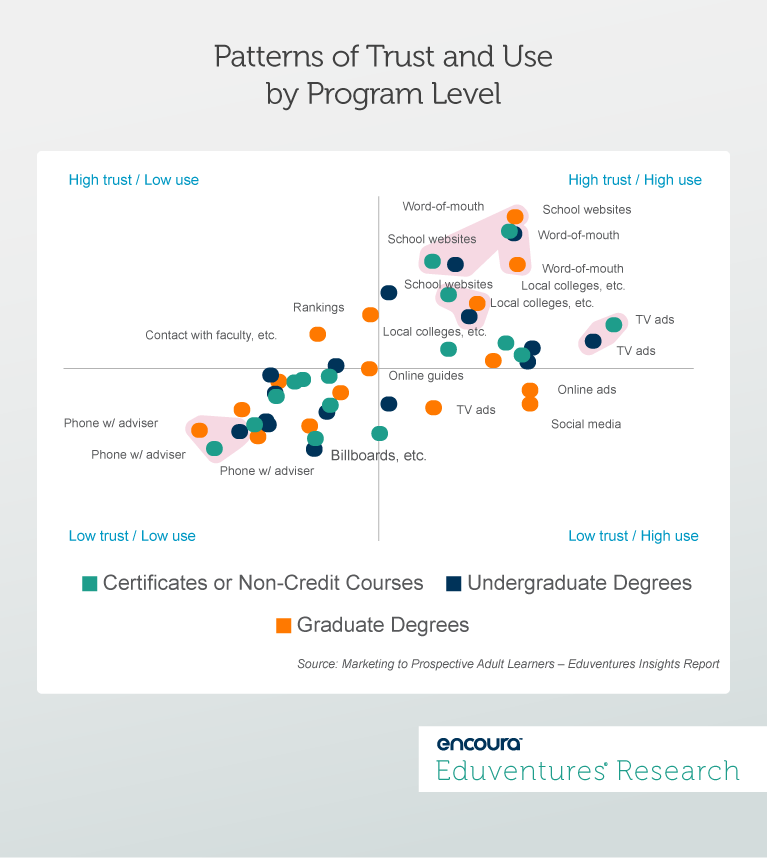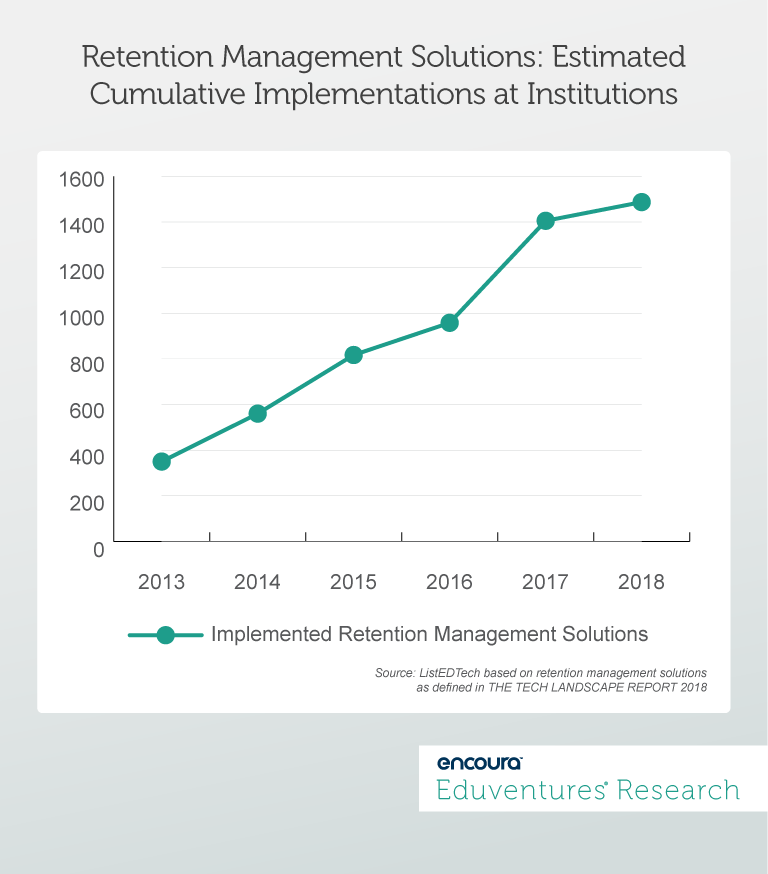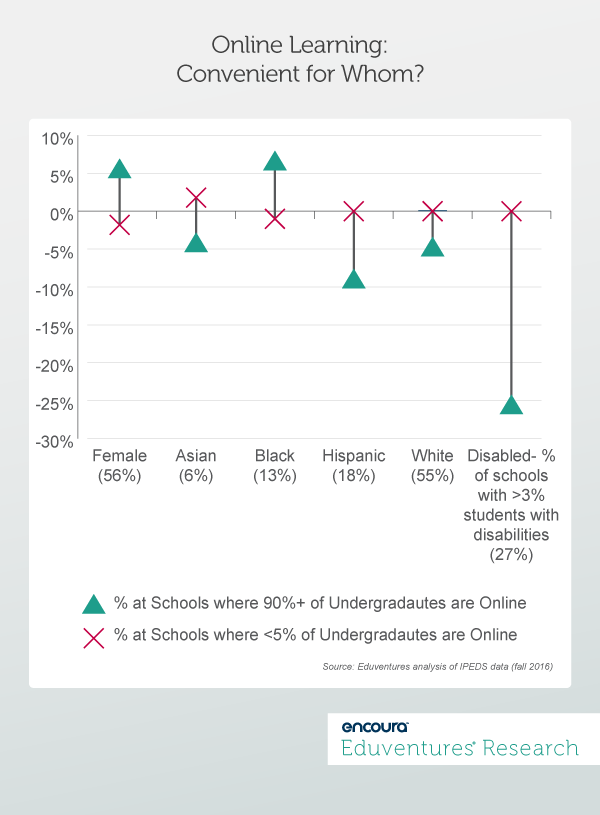Welcome to part two of Eduventures’ Year in Review for 2018! Last week, Chief Research Officer, Richard Garrett, reviewed his higher ed predictions for 2018. This week our analysts share what they learned this year and next week we reveal our Top 5 Wake-Up Calls of the year!
For this post, we asked five Eduventures analysts to As their answers revealed, quite a lot.
For example, we learned more about how much prospective student priorities really shift from application to enrollment (hint: more than you might think). We compared the impact of advertising—and other marketing channels—on both Gen Z (growing) and adults seeking various types of credentials (mixed).
We also answered bigger questions about the common, and often painful, pitfalls universities make when selecting technology solutions, and whether online learning is actually delivering its promise of greater access for all types of students.
These learnings provide a welcome reminder that in this competitive environment, no school can afford to be on autopilot. As we adjust to a new generation of students with changing needs and expectations, having the right data is critical to charting the right course.
So, what did our analysts learn this year? Here is what they said:
It’s time to personalize the recruitment journey for Gen Z.
by Kim Reid
You better watch out … for Gen Z.
by Johanna Trovato
Adult learners remain elusive, skeptical, and discriminating consumers.
by Howard Lurie
It’s better to be smart than lucky.
by James Wiley
Online learning really means access for some.
by Richard Garrett
It’s time to personalize the recruitment journey for Gen Z.
By Kim Reid, Principal Analyst
This year Eduventures analysts traveled to 25 cities across the country to discuss our Prospective Student Mindsets™ (Mindsets) in Regional Summits with more than 100 colleges and universities. I lost track of how many of these Jeffersonian-style discussions I led in person, but they were invaluable to my learning in 2018.
The essence of my learning is that not only do Generation Z (Gen Z) students have different paths in mind for their college education, but they follow different learning journeys even during the enrollment cycle.
The data in Figure 1 comes from students who took both our Prospective Student Survey (labeled “application”) and our Survey of Admitted Students (“enrollment”). It shows how students in different Mindsets prioritize different things at each of these key stages.

This also shows us not only how students initially form dreams about the outcomes of their college education, but also reveals the potential blind spots and opportunities for each type of student.
Essentially, three different stories unfold. Career Pragmatists are consumed with the issue of affordability, but have a major epiphany about the importance of academics along the way. Social Focus students find the vibrant campuses that interest them, but learn to get real about the cost and quality of education. Level-headed headed Career through Academics remain steadfast in their thinking.
Wouldn’t you engage these students differently?
Our in-depth discussions with enrollment professionals teased out ways to use Mindsets to refine recruitment work. Ultimately, we’ve concluded—among other things—that it’s important to illustrate personalized pathways for Gen Z students; that means starting with an understanding the learning journey from the initial enrollment choice into successful student outcomes. (See our Prospective Student Survey Report 2018 for more information).
You better watch out … for Gen Z.
By Johanna Trovato, Senior Analyst
@JohannaTrovato
What did I learn about Generation Z (Gen Z) in 2018? We don’t know as much as we think. In fact, we may have just seen the tip of the Gen Z iceberg. They’re still changing, and continue to surprise us.
Consider these data points from our inaugural 2018 Student Sentiment Survey on information sources that first made college-bound high school sophomores and seniors aware of a particular college or university (Figure 2).

They show strong differences between high school seniors and sophomores that can’t be simply explained by maturity level or college search stage. For instance, this data suggests that as we move deeper into this generation, mobile-friendly admissions processes and the institutional social media strategy will become more important.
Most striking to me, however, is the growing tolerance for advertising. Advertising is far from becoming the most impactful source, but college-bound students indicate they are increasingly paying attention to ads from schools. Online advertising, in particular, seems to be an effective tool for increasing awareness about a college or university.
While advertising remains a four-letter word in many admissions offices that recruit traditional-aged students, the data suggests that future students will have fewer reservations about this type of outreach.
So, you better watch out; not for old St. Nick but for those college-bound high schoolers that are coming down the pipeline. We have heard so much about Gen Z in recent years that it’s quite possible you might have started to tune out. I would advise you to continue to pay attention.
Adult learners remain elusive, skeptical, and discriminating consumers.
By Howard Lurie, Principal Analyst
@EVHowardLurie
In 2018, I deepened my understanding of how prospective adult learners determine “how,” “when,” and “where” they will continue their education. As I explored these questions, I recognized a powerful trope: despite the appeal of a new credential, prospective adult learners remain more elusive consumers, highly skeptical of many of the ways schools communicate with them.
This chart, taken from our Adult Prospect Survey, illustrates the gap between what adult prospects use and what they trust as they search for schools (Figure 3).

In contrast to the growing acceptance among traditional-aged students of conventional marketing techniques, most prospective adult learners do not always use nor trust many of the sources of information schools provided to them. Instead, despite the significant expenditures of many schools, they comb school websites, rely on word-of-mouth, and explore nearby schools.
They are more likely to ignore and place less trust in guides, rankings, and even direct communication with prospective advisors or faculty. And, notably, the largest untapped population of adult learners, those seeking certificates, seem to be most the discriminating.
What are the implications here? Adult-savvy schools will continue to acknowledge that many adult prospects rely on local and informal networks. These schools will also recognize the risk of relying heavily on conventional marketing and outreach efforts to attract and enroll prospective adults.
The tried-and-true methods of how adults choose a school can be surprising or challenging for many schools, but it’s what they trust.
It’s better to be smart than lucky.
By James Wiley, Principal Analyst
@wileyjames
In our conversations with colleges and universities about the Tech Landscape this past year, one thing became apparent: there is surprisingly little attention paid to how a decision about a given technology solution will support the strategic goals of the institution. The endgame of technology selection is almost always about resolving specific tactical problems – improving retention, for example – and rarely about how the solution will help the institution realize its vision of ensuring that its students achieve academic and career success.
Let’s consider the impact this may have on higher education. Using the retention example, over the five years, we estimate that implementations are significantly increasing across all types of schools, including four-year, two-year, public, and private. (Figure 4).

That means that in the retention segment alone, many solutions may not actually align to an institution’s strategic goals. Now apply that to 36 more technology segments.
Does this lead to catastrophe for every one of these universities? Not necessarily, but we suspect that many who do achieve their strategic goals through the use of a new solution do so out of luck, rather than by design. And unfortunately for some, this singular focus on resolving pain points can come at a high cost: a cluttered ecosystem, with each included solution chosen to solve a particular problem.
My hope for 2019 is that technology leaders consider critical questions about the bigger picture in addition to their tactical needs and use a framework to help contextualize and inform their technology selections.
Online learning really means access for some.
By Richard Garrett, Chief Research Officer
Online learning trades on convenience, but for whom? The stereotypical online student is the working adult.
When preparing our forthcoming Online Higher Education Market Update report, I took a closer look at who actually enrolls in online degree programs. The data may surprise you (Figure 5).

Let me explain how to read Figure 5. Females make up 56% of all undergraduates. But the ratio of female students in online schools is 5.4 percentage points higher (i.e., 61%) and 1.8 percentage points lower (i.e., 54%) in schools with very little online. For black students, the online school difference is 6.7 percentage points higher than the 13% baseline (i.e., almost 20%). By contrast, students who are Asian, Hispanic, male, white, and those with disabilities are more likely than average to enroll at schools with few online undergraduates.
Put another way, one population underrepresented in higher education—black students—have turned to fully online learning, but other underrepresented groups—Hispanics, men, and those with disabilities—have not.
Why? High smartphone dependence among Hispanics may limit access to most fully online programs. Some students with disabilities face particular access or support barriers online. Relative lack of male interest suggests that the typical online student experience is seen as no more engaging than the traditional campus.
This is a reminder to think beyond generalizations like the “working adult.” Online can both restrict and enable access. Schools should map their online student body by gender, ethnicity, and disability, and consider adjustments that might increase appeal to underrepresented groups.
In an increasingly crowded online market, segmentation makes sense. The next question is whether students who buy into the promise of online are justified by online outcomes. Look for more from Eduventures on this topic in 2019.
Watch this space next week as we finish our Year in Review with the our Top 5 Wake-Up Calls of the year!
Tuesday, December 11, 2018 at 1PM EDT/12PM CDT
CHLOE, short for the Changing Landscape of Online Education, is now entering its 3rd year, and interest in the content coming from this research continues to climb. The focus of the research has moved beyond earlier foundational questions about online learning to explore a limited series of issues more fully.
Join the webinar to learn how online leaders are addressing the challenges associated with:
- Shared governance
- The development of the chief online officer role
- Quality assurance processes
- How to measure student engagement
- Contrasting institutional models in the online learning landscape
Thank you for subscribing!

